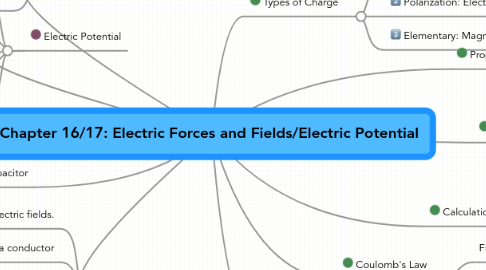Chapter 16/17: Electric Forces and Fields/Electric Potential
создатель Rebecca Harman


1. Electric Potential Energy
1.1. Energy stored in an electric field
1.2. Ue=k(q1*q2)/r
1.3. Signs of Charges determine sign of PE
2. Electric Potential
2.1. Electric potential energy per unit charge
2.2. V=U/q
2.3. 1V=1 J/C
2.4. Potential Difference: change in electric potential energy/unit charge
3. Electric Field and Potential:
3.1. Equipotential Surface
3.1.1. Same potential at every point on the surface
3.1.2. perpendicular to electric field lines at all points
4. Capacitor
4.1. Device that stores electric potential enery by storing separate +/- charges.
4.2. Capacitance: Capability to hold charge for a given potential difference
4.3. Used in memory chips, condensor microphone, oscilloscope
4.4. Discharging:connecting one plate of a charged capacitor with a conducting wire
4.5. Parallel Plate Capacitor(simplest)
4.5.1. two parallel plates with the same area set at a distance
5. Dielectrics
5.1. insulating materials that can withstand large electric fields.
5.2. Strength is the electric field strength at which dielectric breakdown occurs and the material becomes a conductor
5.3. Advantage for use: placing a dielectric between plates increase capacitance.
5.4. Constant: ratio of the electric field in vacuum to electric field within material
5.5. *Stores both charge and energy*
6. Types of Charge
6.1. Constant e=1.602e-19C
6.2. Polarization: Electrically neutral object has areas of +/- charges separate
6.3. Elementary: Magnitude of charge on the proton + electron is equal.
7. Properties of Charge
7.1. *Law of Conservation of Charge*: net charge of a closed system never changes.
7.2. Like Charges repel one another, unlike charges attract one another
8. Means of Charging/Discharging
8.1. Conduction: some charge can move easily
8.2. Charging a conductor: Rubbing
8.3. Semiconductor: intermediate between insulator/conductor
8.3.1. Photoconductor: uses light--no light=insulator, light=conductor
8.4. Insulator: charge does not move easily
8.4.1. Glass, plastic, rubber, wood
8.5. Grounding: process of discharging a conductor
9. Coulomb's Law
9.1. F= k(q1xq2)/r2
9.1.1. k=8.99e9
9.2. F=electrical force each charge exerts on the other
10. Calculations
10.1. Electrical Field(E)=Electric force(F)/q
10.2. F=(k*q*Q)/r2
10.2.1. Q=single point charge
